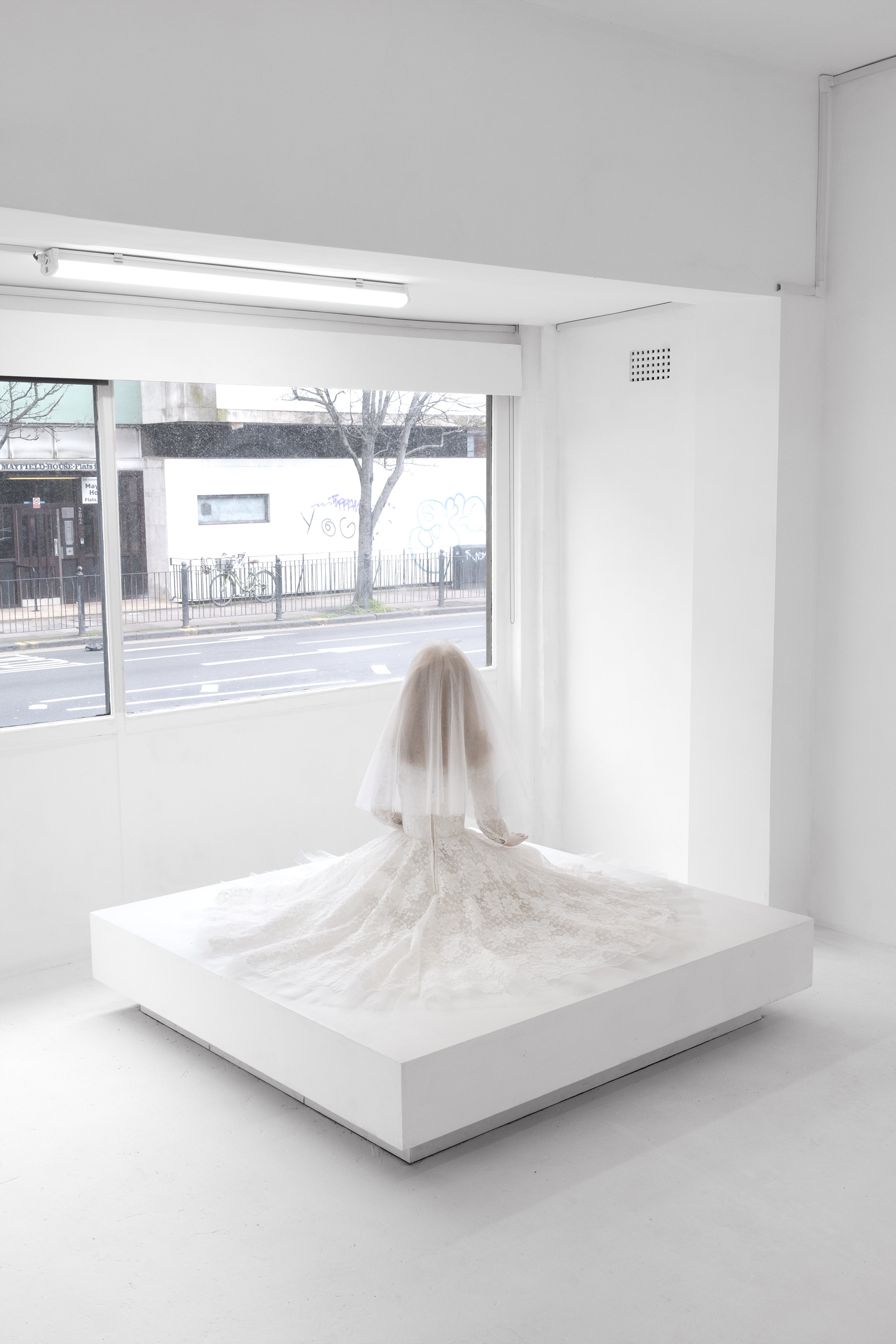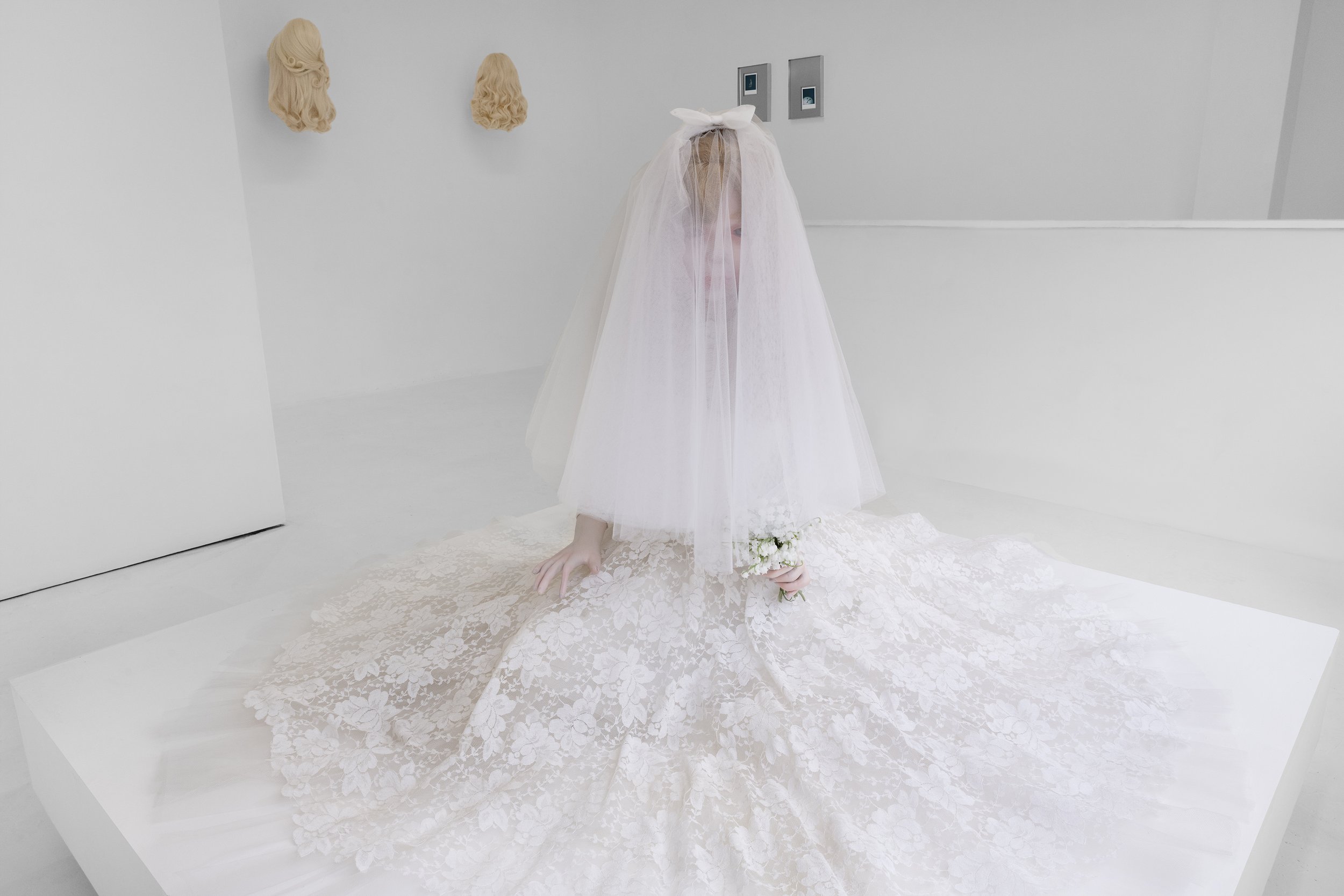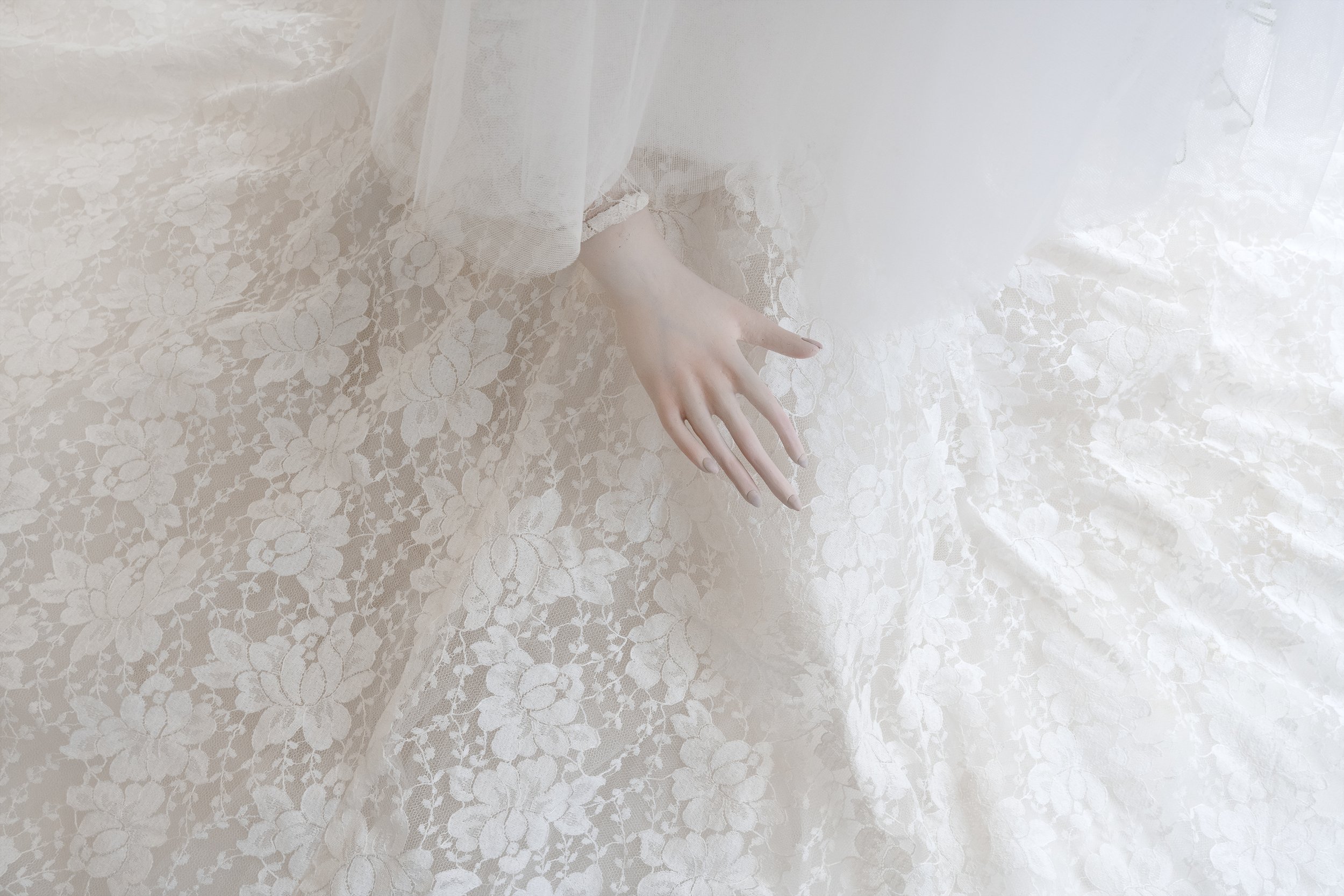LEO COSTELLOE
5 APRIL - 18 MAY 2024
special day
-
NEVEN is delighted to present Special Day, a solo show of new sculptural and photographic work by LEO COSTELLOE. Continuing their interest in the semiotics and functions of adornment, decoration, and feminine archetype, Costelloe here turns their attention to the tropes and material cultures of the Western bride, and her enduring influence on – and subjection to – received notions of ideal femininity, beauty, romantic love, class, and spectacle in the popular imagination.
A bride in full regalia peers up at the gallery window. A 1930s doll, refurbished by Costelloe with toy doctor Joel Davidson and fitted in a traditional white lace wedding gown and veil, Bridal Shop Mannequin 1 (Finsbury Park) is part mannequin, part uncanny protagonist, both object and subject, a cake-topper, a product, an image. Aspirational and romantic, the wedding dress is also a motif entrenched in patriarchal tradition, operating on a symbolic level to infer status, beauty, tradition and distinguish the bride from her guests. In her essay “White Wedding Dress in the Midwest” (2014), Carrie Hertz notes that ‘in the hands of diverse actors, [wedding dresses] become products of labour, works of art, commodities, tools of transformation, overindulgence, or oppression, and tangible markers of individual and social identity. They are dynamic instruments wielded by more than the women who wear them.’ This tension is played out in the popular television show Say Yes to the Dress, in which brides-to-be are dressed and redressed to delighted gasps from onlookers, incentivised to varying degrees by desires of self-expression and legible conformity.
The commodification of feminine idealism is further invoked by two hair sculptures, titled after quintessential bridal styles: Romantic tendrils, Bouncy Curls. Displayed on the wall, they recall hunting trophies in hair nets and ready-made catalog styles, ready for the picking. Nearby, a reception-ready cutlery set combines silver with the trim of a lace garter, mother of pearl, ribbon, and pearls. Titled Something old, something new, something borrowed, something blue (and a silver sixpence), the piece references the traditional Victorian English rhyme detailing what a bride should auspiciously wear for luck on her wedding day.
Superstition is further explored in Always & Forever..., a polaroid of a dove – sacred animal of Aphrodite, Greek goddess of love, and popular wedding iconography –, framed in an etched aluminium mount. Accompanying the dove is a second framed polaroid, this time a portrait of Costelloe’s frequent collaborator, the performance artist Chris Owen. Distinguished only by their veil, this bride is a stranger invocation of the archetypal figure, isolated from any aisle, reception, and groom. Crouched in dark grass, the image takes a visual cue from Sofia Coppola’s 1999 film The Virgin Suicides, loosely referencing Kirsten Dunst’s Lux Lisbon abandoned on a football pitch after an ill-fated one-night fling with suburban heartthrob Trip Fontaine.
By both invoking and estranging recognisable ritual motifs, the exhibition presents both catalogue and critique, at once the uncanny trousseau of the perfect day and the very marker of its fallacies. In exploring the artifice that often underscores our learned ideals, Costelloe assesses the marriage of pressure, perfectionism and capitalism in every little girl’s dream.
-
LEO COSTELLOE (b. 1993, Canberra) is a London-based, Irish-Australian interdisciplinary artist whose work explores the transient and sentimental nature of objects in contemporary culture. Drawing from a zeitgeist of digital femininity, Costelloe’s sculptural practice uses glass, silver, hair and more to infuse banal items with complex emotional and symbolic resonance, informed by the artist’s rural childhood in Australia and grinding coming-of-age in the East London queer scene. With recurring leitmotifs including bows, dolls, stars and flowers, Costelloe’s practice recasts familiar decorative signifiers to reframe an object’s presupposed meanings.
Costelloe has presented solo exhibitions at Ridley Road Project Space, London (2022) and Kupfer, London (2023), and a two-person show at Guts Gallery, London (2023) curated by Helen Neven. Their work has been featured in group exhibitions at Studio West Gallery, London (2024); Indigo + Madder, London (2023); The Stanley & Audrey Burton Gallery, Leeds (2023); General Assembly, London (2023); Kupfer, London (2023); Photobook Gallery, London (2023); Ridley Road Project Space, London (2022).
Costelloe has worked with a variety of brands and institutions including ShowStudio, The British Fashion Council and Dover Street Market, New York. They were awarded the Swarovski Scholar Award (2020) after having been a finalist for the same in 2019. Costelloe graduated from Central Saint Martins with a BA (Hons) in Jewellery Design.
-
The figure of the bride is one of pop culture’s most potent images. She is Grace Kelly becoming a princess in high- necked lace; Priscilla Presley embodying the sixties in her babydoll dress and beehive; Princess Diana ascending to the rank of the most famous woman in the world in whips of taffeta. In Special Day, Leo Costelloe reimagines the interior and exterior world of the bride as a prism for understanding gendered expectations and ideals.
The bride is positioned as perpetually aspirational in popular imagination, updated to fit contemporary trends and reinforced by ideas of women conjuring up their perfect wedding day from girlhood. Even in fashion, an industry that relentlessly pursues representations of ‘now’ and ‘next’, the figure of the bride is still treated with reverence. A tradition that started in the 1940s, a bridal look continues to act as the finale of every couture show— often topped off with a bouquet and a veil or flanked by flower girls.
The couture bride’s gown usually makes its way onto the body of a real bride who wears couture. She might be a famous actress, an It girl or the great granddaughter of an oil man. Either way, her wedding is going to be on vogue.com. ‘The Bride Got Married In A Corset And Cut The Cake In A Floral Bikini.’ ‘The Bride Dressed As A “Texan Marie Antoinette” For Her Ranch Wedding.’ ‘This Fashion Designer Bride Wore Chanel’s Mary-Jane Flats With All Three Of Her Wedding Dresses.’
Sometimes a bride is so good at being a bride that it helps her become a symbol of something bigger yet still invariably tied to feminine identity. The late Carolyn Bessette-Kennedy, publicist and wife of John F. Kennedy Jr., is venerated as a saint of simplicity, a distinction distilled by what she chose to wear the day she got married. Her slip-style wedding dress has its own Wikipedia page with a section dedicated to its influence. Bessette-Kennedy is remembered much the same way her wedding dress is— a woman so elegant and equipped with taste that for her less really was more.
The dress of Sofia Richie-Grainge, daughter of singer Lionel Richie, was similarly received following her 2023 wedding— though it’s likely that Bessette-Kennedy’s style was on her bridal moodboard (and that Richie-Grainge’s legacy will not be nearly as enduring). Richie-Grainge’s three custom Chanel gowns, along with the overall elegance of her wedding weekend and its stately location in the South of France, positioned her as a new rep of bridal sophistication. And while high-profile weddings are often kept under wraps or totally secret, like that of Bessette-Kennedy, Richie-Grainge brought the world right in, launching her TikTok page with a series of candid Get Ready With Me videos posted straight from the heart of her wedding week. As part of this rollout, she shared the details of her take on ‘something old, something new, something borrowed, something blue’— a bridal tradition that Costelloe recontextualises in a mixed media cutlery set by playfully placing emphasis on elements interwoven throughout the bridal trousseau.
If Bessette-Kennedy’s bridal look solidified her public image, Richie-Grainge emerged from her wedding not just a married woman, but a new one. Her “transformation” was analysed, with onlookers comparing Richie-Grainge’s old-money-quiet- luxury image as a bride to the look and lifestyle of her past— from the shade of blonde and clothes she wore to the partner that accompanied her. Her wedding day alchemized a brassy bleach job into a honey blonde chignon, influencercore into couture, and in the case of the man by her side, a frog into a prince, as a sleazy side character on reality TV became a doting Brit with deep pockets and pedigree.
But more often than not, a Cinderella-style romance is more a return to or a reaffirmation of roots than a true transformation. Sure, Richie-Grainge married into music royalty— her husband’s father is a major record label executive— but she was born into it first. Similarly, New York City socialite Tinsley Mortimer, whose unlucky-in-love story shaped her narrative on the Real Housewives of New York (and in the press), finally found love with a Georgia businessman, returning home to her native South to start married life.
Despite the large amount of screen time occupied by celebrity weddings, the figure of the bride is endangered today. Around the world, less people are getting married. And when they do, they’re cutting back. Courthouse weddings, once viewed as the unglamorous choice for those restricted by cost or circumstance, are on the rise. For every vogue. com bride, there’s tons of brides-to-be sharing money- saving tips online— from supermarket wedding cakes to killing the open bar and asking family members to work the reception. Of course, less of a thing around can make it more special to behold. That’s why it feels like there’s a little extra baited breath around the luxury hotel bathroom GRWMs, vogue.com brides, those who can still afford fairytale.
But this inaccessibility also means that the datedness or lack of formality that would’ve previously marked a wedding as pedestrian or lacking taste can now work as an embellishment rather than a stain. Lana Del Rey appeared on the March 2023 cover of Interview magazine dressed as this kind of bride— eyelet wedding dress and a veil, unlit cigarette dangling from glossed lips, blue eyeshadow and a vacant expression gazing through a parking lot. In another photo from the story, she sits on the hood of a car laughing over a paper-bagged beer, this time in a bridal mini dress. The cover proved to be a memorable image, igniting its own mini-mania for the symbol of the bride— this time by way of the Dollar Store rather than the Hotel du Cap-Eden-Roc. Girls dressed up like the cover for Halloween, tacking on veils and relaxing their faces into empty expressions structured by cigarettes for photos. A newly wed celebrating in a parking lot couldn’t be further away from a celebrity at the perfumed center of a million dollar ceremony, but our obsession with both proves that we still can’t get enough of the woman-made-bride.
-















